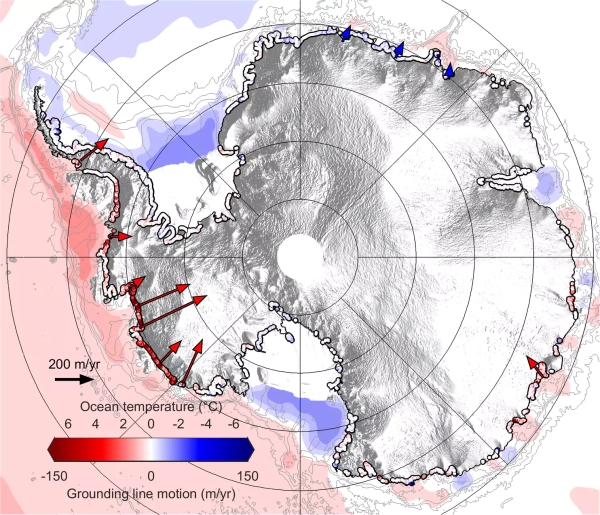Rapid Sea Level Rise Possible as Ocean Floods into Antarctica at up to 400 Meters Per Year
From west to east and in a growing number of places, a warming ocean is cutting its way deep into Antarctica. Grounding lines — the bases upon which mile-high glaciers come to rest as they meet the water — are in rapid retreat. And this ocean, heated by human fossil fuel burning, is beginning to flood chasms that tunnel for hundreds of miles beneath great mountains of ice.
Such an immense flood has the effect of speeding up glaciers as far away as 500 miles from the point of invasion. It does this by generating a kind of abyssal pit that the glacier more swiftly falls into. And as these watery pits widen, they risk pumping sea level rise to catastrophic levels of ten feet or more by the end of this Century.
(A new study in Nature is the first to survey the rate of grounding line movement around Antarctica’s entire perimeter. What it found was disturbing. A large number of major glaciers are seeing historically rapid rates of grounding line retreat [red arrows] as only a few glaciers show very slow rates of grounding line advance [blue arrows]. Image source: Hannes Konrad et al, Nature, University of Leeds.)
The great ocean invasion is clearly on the march. Not yet proceeding everywhere, the advance is happening in enough places to cause major worry. In West Antarctica, 22 percent of its glaciers are seeing their grounding lines move inland by more than 25 meters per year. In the Antarctic Peninsula, 10 percent of glaciers are experiencing this retreat. And in East Antarctica, where the ice is piled thickest, 3 percent of glaciers are affected by the swift invasion.
The most rapid retreat — at up to 400 meters per year — is presently happening at Thwaites Glacier in West Antarctica. Thwaites alone encompasses enough ice to lift the world’s oceans by 3 meters. And the rate of inland ocean water invasion at this single location is a very serious concern.
(Grounding line retreat is just one of many factors that increase the risk of rapid sea level rise. Ice cliff instability, increased rainfall over glaciers, large floods of water into glaciers from melt ponds that then refreeze and fracture the ice, and a number of other factors all compound as the Earth is heated up by fossil fuel burning. Video source: International Business Times.)
But the issue is not one of single glaciers. It’s one where many very large mounds of ice all around Antarctica are under threat. And in much the same way that a dike risks breaking apart when it is punched through by a growing number of holes, Antarctica’s own flood gates to rapid sea level rise are threatened by each grounding line in quickening retreat. Another such ‘hole’ has formed at the Totten Glacier where the grounding line is retreating at around 150 to 175 meters per year. And Totten could produce another 3.4 meters of sea level rise if it collapsed into the Southern Ocean.
Continuing the dike anology, Antarctica holds back enough water as ice, in total, to lift the world’s ocean levels by an average of 200 feet. By greater or lesser degrees, each retreating glacier contains a portion of the potentially massive flood. And the overall rate of loss in the form of new glaciers going into retreat together with the pace of inland ocean invasion is speeding up.
This new set of research provides a more complete if fearsome picture of Antarctic melt. And though models aren’t yet able to pinpoint how fast sea level rise will be, a growing body of evidence points to greater than previously expected risk for rapid sea level rise this Century. So for the sake of our coastlines and of so many cities around the world, the time to act as swiftly as possible to reduce carbon emissions and their terrible related impacts is now.



Geen opmerkingen:
Een reactie posten